What's inside
What's inside
 Key Ingredients
Key Ingredients

No key ingredients
 Benefits
Benefits

 Concerns
Concerns

 Ingredients Side-by-side
Ingredients Side-by-side

Water
Skin ConditioningSodium Lauroyl Methyl Isethionate
CleansingCocamidopropyl Betaine
CleansingSodium Lauroyl Sarcosinate
CleansingPPG-2 Hydroxyethyl Coco/Isostearamide
Argania Spinosa Kernel Oil
EmollientAloe Barbadensis Leaf Juice
Skin ConditioningHydrolyzed Quinoa
Skin ConditioningHydrolyzed Vegetable Protein Pg-Propyl Silanetriol
Skin ConditioningHelianthus Annuus Seed Extract
Skin ConditioningAlanine
MaskingArginine
MaskingAspartic Acid
MaskingGlycine
BufferingHistidine
HumectantIsoleucine
Skin ConditioningPhenylalanine
MaskingProline
Skin ConditioningSerine
MaskingThreonine
Valine
MaskingPanthenol
Skin ConditioningGlycol Distearate
EmollientSodium Cocoyl Isethionate
CleansingPEG-150 Pentaerythrityl Tetrastearate
EmulsifyingParfum
MaskingCitric Acid
BufferingSilicone Quaternium-8
Trisodium Ethylenediamine Disuccinate
Guar Hydroxypropyltrimonium Chloride
Skin ConditioningTetrasodium Glutamate Diacetate
Polyquaternium-7
Glycerin
HumectantSodium Laurate
CleansingDisodium EDTA
Polyquaternium-44
Coconut Acid
CleansingSodium PCA
HumectantSodium Lactate
BufferingSodium Isethionate
CleansingMagnesium Nitrate
PCA
HumectantSodium Sarcosinate
Ethylhexylglycerin
Skin ConditioningTrimethylsiloxyamodimethicone
Sodium Hydroxide
BufferingSodium Glycolate
BufferingC11-15 Pareth-7
EmulsifyingSodium Formate
BufferingQuaternium-95
UV AbsorberC12-16 Pareth-9
EmulsifyingPropanediol
SolventTrideceth-12
EmulsifyingPhenoxyethanol
PreservativeSodium Benzoate
MaskingMethylchloroisothiazolinone
PreservativeMethylisothiazolinone
PreservativeBenzyl Alcohol
PerfumingPotassium Sorbate
PreservativeHydroxycitronellal
PerfumingButylphenyl Methylpropional
PerfumingLimonene
PerfumingWater, Sodium Lauroyl Methyl Isethionate, Cocamidopropyl Betaine, Sodium Lauroyl Sarcosinate, PPG-2 Hydroxyethyl Coco/Isostearamide, Argania Spinosa Kernel Oil, Aloe Barbadensis Leaf Juice, Hydrolyzed Quinoa, Hydrolyzed Vegetable Protein Pg-Propyl Silanetriol, Helianthus Annuus Seed Extract, Alanine, Arginine, Aspartic Acid, Glycine, Histidine, Isoleucine, Phenylalanine, Proline, Serine, Threonine, Valine, Panthenol, Glycol Distearate, Sodium Cocoyl Isethionate, PEG-150 Pentaerythrityl Tetrastearate, Parfum, Citric Acid, Silicone Quaternium-8, Trisodium Ethylenediamine Disuccinate, Guar Hydroxypropyltrimonium Chloride, Tetrasodium Glutamate Diacetate, Polyquaternium-7, Glycerin, Sodium Laurate, Disodium EDTA, Polyquaternium-44, Coconut Acid, Sodium PCA, Sodium Lactate, Sodium Isethionate, Magnesium Nitrate, PCA, Sodium Sarcosinate, Ethylhexylglycerin, Trimethylsiloxyamodimethicone, Sodium Hydroxide, Sodium Glycolate, C11-15 Pareth-7, Sodium Formate, Quaternium-95, C12-16 Pareth-9, Propanediol, Trideceth-12, Phenoxyethanol, Sodium Benzoate, Methylchloroisothiazolinone, Methylisothiazolinone, Benzyl Alcohol, Potassium Sorbate, Hydroxycitronellal, Butylphenyl Methylpropional, Limonene
Lactobacillus/Arundinaria Gigantea Ferment Filtrate
Skin ConditioningGlycerin
HumectantLactobacillus Ferment
Skin ConditioningStearyl Alcohol
EmollientCocos Nucifera Fruit Extract
EmollientSqualane
EmollientPhyllostachys Bambusoides Extract
Skin ConditioningSalvia Hispanica Seed Extract
EmollientSaccharomyces Cerevisiae Extract
Skin ConditioningBehentrimonium Methosulfate
Cyamopsis Tetragonoloba Gum
Emulsion StabilisingPCA Glyceryl Oleate
EmollientSelaginella Lepidophylla Extract
EmollientCetyl Alcohol
EmollientEuterpe Oleracea Sterols
Skin ConditioningParfum
MaskingLinalool
PerfumingButylene Glycol
HumectantLimonene
PerfumingLinoleic Acid
CleansingOleic Acid
EmollientCitral
PerfumingLinolenic Acid
CleansingLactobacillus/Arundinaria Gigantea Ferment Filtrate, Glycerin, Lactobacillus Ferment, Stearyl Alcohol, Cocos Nucifera Fruit Extract, Squalane, Phyllostachys Bambusoides Extract, Salvia Hispanica Seed Extract, Saccharomyces Cerevisiae Extract, Behentrimonium Methosulfate, Cyamopsis Tetragonoloba Gum, PCA Glyceryl Oleate, Selaginella Lepidophylla Extract, Cetyl Alcohol, Euterpe Oleracea Sterols, Parfum, Linalool, Butylene Glycol, Limonene, Linoleic Acid, Oleic Acid, Citral, Linolenic Acid
Alternatives
Ingredients Explained
These ingredients are found in both products.
Ingredients higher up in an ingredient list are typically present in a larger amount.
Glycerin is already naturally found in your skin. It helps moisturize and protect your skin.
A study from 2016 found glycerin to be more effective as a humectant than AHAs and hyaluronic acid.
As a humectant, it helps the skin stay hydrated by pulling moisture to your skin. The low molecular weight of glycerin allows it to pull moisture into the deeper layers of your skin.
Hydrated skin improves your skin barrier; Your skin barrier helps protect against irritants and bacteria.
Glycerin has also been found to have antimicrobial and antiviral properties. Due to these properties, glycerin is often used in wound and burn treatments.
In cosmetics, glycerin is usually derived from plants such as soybean or palm. However, it can also be sourced from animals, such as tallow or animal fat.
This ingredient is organic, colorless, odorless, and non-toxic.
Glycerin is the name for this ingredient in American English. British English uses Glycerol/Glycerine.
Learn more about GlycerinLimonene is a fragrance that adds scent and taste to a formulation.
It's found in the peel oil of citrus fruits and other plants such as lavender and eucalyptus. The scent of limonene is generally described as "sweet citrus".
Limonene acts as an antioxidant, meaning it helps neutralize free radicals.
When exposed to air, oxidized limonene may sensitize the skin. Because of this, limonene is often avoided by people with sensitive skin.
The term 'fragrance' is not regulated in many countries. In many cases, it is up to the brand to define this term. For instance, many brands choose to label themselves as "fragrance-free" because they are not using synthetic fragrances. However, their products may still contain ingredients such as essential oils that are considered a fragrance.
Learn more about LimoneneParfum is a catch-all term for an ingredient or more that is used to give a scent to products.
Also called "fragrance", this ingredient can be a blend of hundreds of chemicals or plant oils. This means every product with "fragrance" or "parfum" in the ingredients list is a different mixture.
For instance, Habanolide is a proprietary trade name for a specific aroma chemical. When used as a fragrance ingredient in cosmetics, most aroma chemicals fall under the broad labeling category of “FRAGRANCE” or “PARFUM” according to EU and US regulations.
The term 'parfum' or 'fragrance' is not regulated in many countries. In many cases, it is up to the brand to define this term.
For instance, many brands choose to label themselves as "fragrance-free" because they are not using synthetic fragrances. However, their products may still contain ingredients such as essential oils that are considered a fragrance by INCI standards.
One example is Calendula flower extract. Calendula is an essential oil that still imparts a scent or 'fragrance'.
Depending on the blend, the ingredients in the mixture can cause allergies and sensitivities on the skin. Some ingredients that are known EU allergens include linalool and citronellol.
Parfum can also be used to mask or cover an unpleasant scent.
The bottom line is: not all fragrances/parfum/ingredients are created equally. If you are worried about fragrances, we recommend taking a closer look at an ingredient. And of course, we always recommend speaking with a professional.
Learn more about Parfum